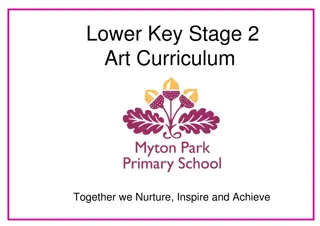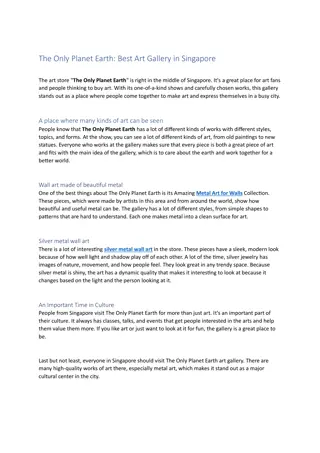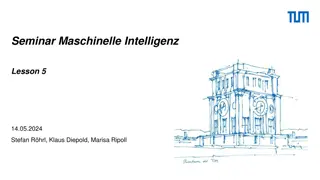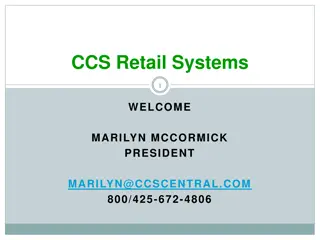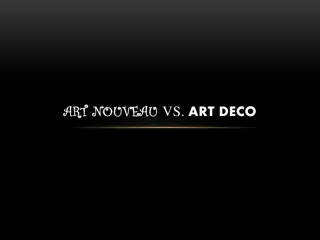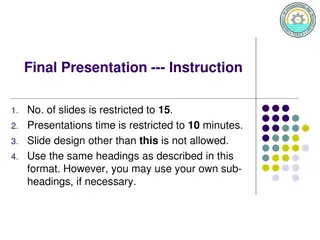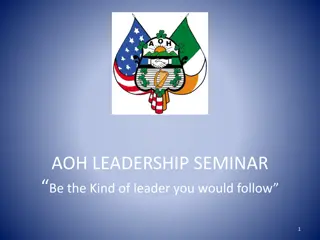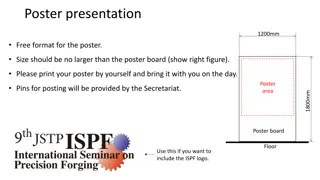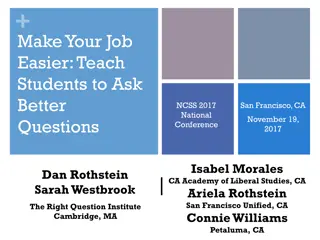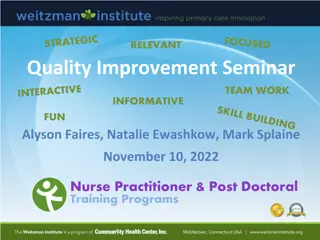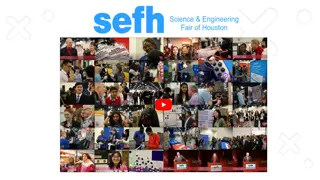The Art and Science of the QFT Seminar
Explore the collaborative learning techniques of the Question Formulation Technique (QFT) at the PNW BOCES seminar. Delve into the methodology of formulating questions, building consensus for change, and planning for effective implementation. Access materials and resources from The Right Question Institute to enhance your teaching strategies. Gain insights from examples of using QFT in science and engineering, aligning with the new science standards. Engage in lesson planning discussions and discover the impact of asking questions in defining problems and promoting scientific inquiry.
Download Presentation

Please find below an Image/Link to download the presentation.
The content on the website is provided AS IS for your information and personal use only. It may not be sold, licensed, or shared on other websites without obtaining consent from the author. Download presentation by click this link. If you encounter any issues during the download, it is possible that the publisher has removed the file from their server.
E N D
Presentation Transcript
+ The Art and Science of the QFT PNW BOCES Yorktown Heights, NY October 19, 2017 | Dan Rothstein Co-Director Siyi Chu Program Associate The Right Question Institute
+ Today s Agenda Welcome 1) Collaborative Learning with the Question Formulation Technique (QFT) 2) The Art and Science of the QFT 3) Lunch 4) Building Consensus for Change by Using the Right Question Strategy 5) Planning to Bring the QFT Back 6) Closing Remarks, Q&A, & Evaluations @RightQuestion @RothsteinDan #QFT 7)
+ To Access Today s Materials: http://rightquestion.org/educators/ seminar-resources/ Join our Educator Network for: Templates you can use tomorrow in class Classroom Examples Instructional Videos Forums and Discussions with other Educators
+ To Access Today s Materials: The Right Question Institute offers our materials through a Creative Commons License and we encourage you to make use of and/or share this resource. Please reference the Right Question Institute and rightquestion.org as the source on any materials you use.
+Review a Lesson Planning Workbook Name some of the challenges of planning a lesson or session with the QFT. What part or pieces seems particularly tricky? Look at how the workbook is structured. What do you notice? What seems helpful or useful about this planning tool? What questions do you have about planning so far?
+ A PNW Examples of Using the QFT in Science and Engineering David Jacob Regional Science Coordinator Putnam North Westchester BOCES
+QFT and the New Science Standards Science and Engineering Practice Practice the Practice: Asking Questions and Defining Problems Students at any grade level should be able to ask questions of each other about the texts they read, the features of the phenomena they observe, and the conclusions they draw from their models or scientific investigations. For engineering, they should ask questions to define the problem to be solved and to elicit ideas that lead to the constraints and specifications for its solution. (NRC Framework 2012, p. 56)
+Grade 2 QFT about Playground Equipment
+ Science 21 and Grade 2 Curriculum Teacher Comments: We had great results doing it in our class with dividing the class into 3 groups where teachers could record questions and work in smaller groups with the students The share outs after each part of the QFT process helped the kids see the similarities in their thinking and also different questions that were raised
+ QFT: An ART and a SCIENCE The QFT Discuss the rules Present a Question Focus Improve questions Prioritize questions Discuss next steps Reflect The Science: 1. A rigorous protocol, with specific steps and sequence, that produces consistent results 2. 3. 4. 5. 6.
+QFT: An ART and a SCIENCE Tailor the QFT through: The Art: Design of the Question Focus (Qfocus) Tailoring the QFT process to the specific content and students you are teaching. Instructions for prioritizing Next steps for using the questions Reflection questions Facilitation
+Five Areas Related to the Art of the QFT Linking the QFT to Teaching and Learning Goals QFocus Design Prioritization Instructions Reflection Questions Facilitation 1. 2. 3. 4. 5.
+Various Teaching Purposes Engagement Knowledge acquisition Formative assessment Summative assessment Peer review Skill development
+Using the QFT for Peer Review: Scientist s claim: Adding a dam to a water system causes a decrease in aquatic life downstream. Student Design to test the claim:
+Using the QFT for Skill Development (Students were assigned a complex molecular biology article) QFocus: Ask as many questions as you can about the reading
+Next Steps with Student Questions: Students generate questions for homework then bring in to class Students discuss key attributes of a good biological research question and compare to other types of questions Students form groups and improve their questions, based on these attributes These questions are discarded or kept in notebooks (up to the student) Students apply this skill to designing their own research project later in the semester
+Next Steps? Pop Quiz or Reading Check Debate Prep Paper topic Lab work & Experiments Exit ticket or Do Now Research Projects Hang on walls, Check Off as Answered Test Prep Homework And sometimes Class discussion prompts Presentations Student Choice Projects Nothing! Socratic Seminar Prompts Interview an Expert Make Your Own Final Test Guest speakers Journal Prompt Close Reading Protocol Year-long or Unit-long Essential Questions Tailoring Instruction Service Action Projects
+Five Areas Related to the Art of the QFT Linking the QFT to Teaching and Learning Goals QFocus Design Prioritization Instructions Reflection Questions Facilitation 1. 2. 3. 4. 5.
+ Classroom Example: High School Teacher: Joan Soble, Cambridge, MA Topic: Albert Camus s The Plague Purpose: Pre-readingengagement and prediction of central themes going into the text
+Revised Question Focus: The city fathers were aware that the decaying bodies of these rodents were making people sick. (page 28)
+ Question Focus Design: Moving From Complicated to Simple
+ Classroom Example: 2nd Grade Teacher: Marie Romero, Lanai, Hawaii Topic: A unit on How can a pet be an important friend? Purpose: Let students generate their own key question for the week, assess how well students are able to ask questions
+ Initial Question Focus Design Process How can a pet be an important friend? Collage of pictures: dogs, cats, guinea pigs, horses, other pets Picture of a human and a service animal Picture of a human and a service animal paired with a phrase like people and animals People and animals People, animals, and friends
+Student Questions: People, Animals, and Friends 1. Do people exist? 11. Why do people want to be friends with animals? 2. Where do people live? 12. Why are people making friends with animals? 3. Why do animals live in the zoo? 4. Why do people go to the pool? 13. Why do people, animal, and friends live in different countries? 5. Why are friends fun? 14. Where did my dog and friend go? 6. Why do animals bite? 15. Can my friend pet our new dog? 7. Why do people go to school? 16. Why do I have eyes? 8. Do people, animals, and friends play together? 17. How do people smell? 9. Do animals make friends? 18. Can animals speak? 10. Why do I need friends? 19. Can people fly? 20. Where is my bunny? What happened?
+Revising the Question Focus People, Animals, and Friends Your idea here!
+ The one quality all excellent QFT designers share? Thick Skin.
+Five Areas Related to the Art of the QFT Linking the QFT to Teaching and Learning Goals QFocus Design Prioritization Instructions Reflection Questions Facilitation 1. 2. 3. 4. 5.
+Prioritization Instructions Choose the three most important questions Choose the three questions you consider most important.
+Categories of Prioritization Instructions Choose three questions General Instructions: that you consider most important Specific Purposes: that you need to research further to help you solve the problem that you need to answer first that a scientist studying the earth might ask that will help you understand the text that require analyzing data that are not Googleable and may be difficult to answer
+Five Areas Related to the Art of the QFT Linking the QFT to Teaching and Learning Goals QFocus Design Prioritization Instructions Reflection Questions Facilitation 1. 2. 3. 4. 5.
+Examples of Reflection Questions QFT Process Content Specific What did you learn about asking questions? What did you learn about the (content)? How did the QFT process help you think about key concept specific assignment overarching topic theme in the unit chapter you just read How did you learn it? What do you understand differently now about asking questions? How can you use what you learned about asking questions? How do you feel about asking questions?
+Five Areas Related to the Art of the QFT Linking the QFT to Teaching and Learning Goals QFocus Design Prioritization Instructions Reflection Questions Facilitation 1. 2. 3. 4. 5.
+Four Principles of Facilitation Monitor student adherence to the process 1. Do not give examples 2. Do not get pulled into group discussion 3. Acknowledge all contributions equally 4. Pair & Share: What could be challenging about each principle? What might be important about each?
+ The Science of the QFT: a protocol The Art of the QFT: You
+ Today s Agenda Welcome 1) Collaborative Learning with the Question Formulation Technique (QFT) 2) The Art and Science of the QFT 3) Lunch 4) Building Consensus for Change by Using the Right Question Strategy 5) Planning to Bring the QFT Back 6) Closing Remarks, Q&A, & Evaluations 7) @RightQuestion #QFTCon #QFT
+ Today s Agenda Welcome 1) Collaborative Learning with the Question Formulation Technique (QFT) 2) The Art and Science of the QFT 3) Lunch 4) Building Consensus for Change by Using the Right Question Strategy 5) Planning to Bring the QFT Back 6) Closing Remarks, Q&A, & Evaluations 7) @RightQuestion #QFTCon #QFT



